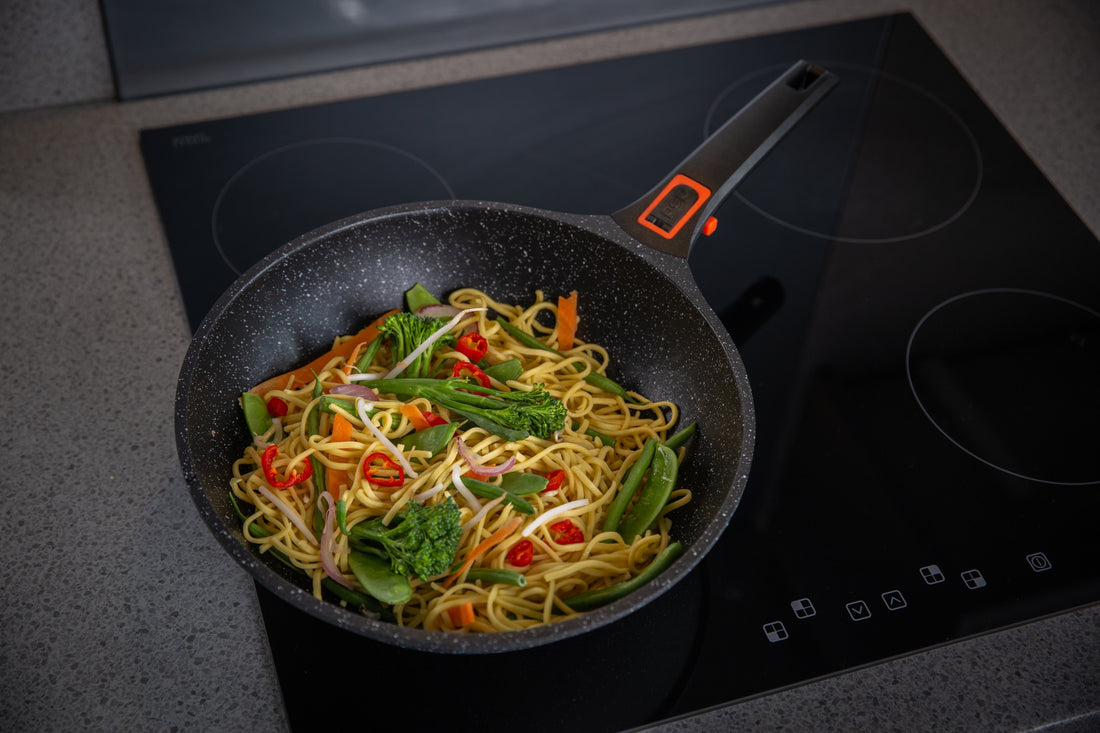The Art and Science Behind Stir-Frying in a Wok: Exploring Tradition, Technique, and Taste
Stir-frying is more than just a way of cooking - it's an art form that has been perfected over centuries in Asian cuisine. At the heart of this culinary tradition is the iconic wok - a versatile, deep pan that is both a practical tool and a symbol of cultural heritage. In this exploration, we'll dive into why stir-frying in a wok remains unmatched, uncovering the secrets behind its enduring popularity and unbeatable flavours.
- A Brief History of the Wok:
The wok is a remarkable cooking vessel with a rich history tracing back over two millennia in China. This humble yet mighty pan has stood the test of time, evolving alongside the culinary traditions of various Asian cultures. Initially crafted from cast iron, woks were designed to withstand the intense heat of traditional Chinese cooking methods, such as stir-frying, steaming, and deep-frying.
Over the centuries, the wok's design has undergone subtle refinements, with different regions developing their own unique variations. From the flat-bottomed woks favoured in Cantonese cuisine to the round-bottomed woks ubiquitous in Sichuan cooking, each style offers its own set of advantages, catering to the diverse culinary needs of chefs across Asia and beyond. Understanding the significance of the wok in stir-frying requires an appreciation for this storied piece of cookware and its enduring impact on the culinary world.
- The Science of Stir-Frying:
Stir-frying is a high-heat cooking method where bite-sized food pieces are quickly cooked in a small amount of oil. The key to good stir-frying is keeping the temperature consistent while constantly moving the ingredients around the wok. This quick cooking helps preserve the natural flavours and textures, resulting in vibrant, aromatic dishes.
The shape of the wok is crucial. The sloped sides allow for easy tossing and stirring, ensuring even and fast cooking. The wide surface area also promotes evaporation, preventing the food from getting soggy and keeping it crisp - a hallmark of well-done stir-fries.
- Versatility in the Kitchen:
The wok is an incredibly versatile cooking tool. Whether you're sautéing vegetables, searing meat, or steaming dumplings, the wok can handle it all with ease. Its deep, rounded shape provides plenty of room for tossing and flipping ingredients, making it perfect for both quick weeknight meals and more elaborate multi-dish feasts.
The wok's ability to evenly distribute heat ensures that food cooks quickly and efficiently, a benefit for both busy home cooks and professional chefs. From spicy Sichuan stir-fries to delicate Cantonese delicacies, the wok adapts seamlessly to a wide range of cooking styles and flavour profiles, making it an essential staple in kitchens worldwide.
- Health Benefits of Stir-Frying:
Stir-frying in a wok offers more than just delicious food. It's also a healthier cooking method compared to deep-frying. Deep-frying requires a lot of oil, resulting in greasy, calorie-heavy dishes. In contrast, stir-frying only needs a small amount of oil, making it a lighter and healthier option.
The quick cooking time of stir-frying helps preserve the nutritional value of the ingredients. Vegetables retain their vibrant colours and crisp textures, while the meat stays tender and juicy. This shows the power of high-heat cooking. By using fresh, seasonal ingredients in your stir-fries, you can create nutritious meals that are both good for your body and your taste buds.
- Cultural Significance and Tradition:
Stir-frying in a wok holds deep cultural significance for many Asian communities beyond its practical benefits. In China, the wok is seen as a symbol of family and unity, with generations of cooks passing down their culinary knowledge from one kitchen to another. Similarly, in countries like Thailand, Malaysia, and Singapore, the wok plays a central role in traditional cooking practices, connecting people to their cultural heritage through the shared experience of preparing and enjoying stir-fried dishes.
The art of stir-frying also embodies principles of balance and harmony. Chefs carefully select ingredients and balance flavours to create dishes that are both satisfying and nourishing. From the bold heat of chilies to the subtle sweetness of soy sauce, each element plays a crucial role in the overall composition of the dish, reflecting the complex interplay of flavours that defines Asian cuisine.
- Tips for Perfect Stir-Fries:
Stir-frying in a wok may seem tricky for beginners, but with a little practice, you can master this cooking technique. Here are some handy tips to help you achieve perfect stir-fries:
- First, make sure to thoroughly preheat your wok before adding any ingredients. This will ensure even cooking.
- Use oils with high smoke points, like peanut or vegetable oil, to prevent burning and maintain a neutral flavour.
- When cooking, keep the ingredients moving constantly by tossing and stirring. This prevents sticking and ensures even cooking.
- Avoid overcrowding the wok - cook in batches if needed to maintain the right amount of space.
- Start by sautéing aromatic ingredients like garlic and ginger. This infuses the entire dish with delicious flavour from the beginning.
- Finally, finish your stir-fry by drizzling over a savoury sauce or glaze right before serving.
With these simple tips, you'll be whipping up restaurant-worthy stir-fries in no time!
Stir-frying in a wok is much more than just a cooking method. It's a culinary journey rooted in tradition, technique, and taste. From its origins in ancient China to its widespread popularity worldwide, the wok continues to captivate cooks of all skill levels. By harnessing the power of high-heat cooking and embracing the wok's versatility, you can unlock a world of flavour and creativity in your own kitchen. So the next time you're craving a quick and delicious meal, reach for your trusty wok and let the magic begin.
Fancy cooking with a Wok? Check out our Pep Wok HERE!
Happy stir-frying!

